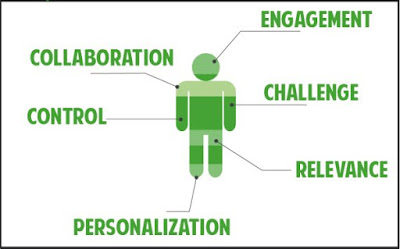If collaboration is one of the hallmarks of the new E-Learning paradigm then it is important not only to encourage it in learners but also be willing to model it as an important professional practice. In the last post I suggested that there is much that we can learn about interactivity and engagement from the serious game designers. Many of the remarks in further elaborating on the hybrid model in this post will draw from the serious game designer's experience. One distinction I would make based upon the current state of "gamification" is that I believe that at the present time gamification does not have the same research and application rigor that "serious game design" does. Therefore, it is from the latter that I will draw comparisons from.
Ironically, the best teacher of learning from mistakes and taking on higher and higher levels of difficulty without outside coercion comes from the gaming industry. It is this industry that we need to have more and more helpful conversations in creating effective interactivity.
Next---How immediate and ongoing feedback during a learning experience leads to deeper learning.
 |
| Credit: www.info.shiftlearning.com |
The Nature of Interactive Learning Experiences in the Hybrid Model
It should be recognized that relevant challenges within E-Learning experiences are key to the engagement of the learner in the activity so that the learner's intrinsic motivation becomes more stronger than any extrinsic motivators that may be in play at the beginning. In such a situation, the learner enters into what might be described as a "state of flow" where the learner seeks to actively engage with the experience on many levels. The shape that this may take could involve the learner actively, either as an individual or on a collaborative level, seeking to gather information needed to solve a task, re-thinking and re-formulating the approach to the task and generally going beyond the original parameters in order to come to terms with a tasked problem. For the learner, it takes on the same addictive nature that is seen in well designed serious games.
 |
| Credit: www.LinkedIn.com |
These are some of the qualities that can be observed of participants who are involved in a well designed "serious game". The nature of the challenges within E-Learning experiences are such that goals and objectives are re-defined as progress is made during the learning experience. This means that goals and objectives need to be agile and adaptive because in an online environment unlike in traditional learning environments, feedback to the learner is immediate during the experience and in fact impacts the decision making process of the individual or collaborative group in a dynamic fashion.
In the past, course objectives were written based upon Bloom's Taxonomy which was a valuable resource to start from but it is not a linear dynamic in an online environment and the "revised" Bloom's Taxonomy is more relevant to a digital age. Creating the environment where innovative ideas become a natural mindset requires that this level be considered and that movement does not proceed in an unidirectional linear fashion. This is especially evident when a collaborative group is involved in real world problem solving.
Level of Difficulty and Learning From Mistakes
Another important consideration in designing effective interactivity in E-Learning experiences is to make sure that E-Learning activities are neither too easy or too difficult. This especially true for corporate learners.
"Why is this a necessary guide and should we be happy with this state of affairs?"
To begin to address the above question, we need to look to the past experiences of learners:
- They were all educated in an education system that empowered them to believe that if they found something too difficult, that someone else would either change the activity, lower the standard for achievement or allow them to give up on doing the activity with very few personal repercussions for doing so.
- They were taught that at least putting in the effort was just as important as actually achieving what was required.
Ironically, the best teacher of learning from mistakes and taking on higher and higher levels of difficulty without outside coercion comes from the gaming industry. It is this industry that we need to have more and more helpful conversations in creating effective interactivity.
Next---How immediate and ongoing feedback during a learning experience leads to deeper learning.

No comments:
Post a Comment